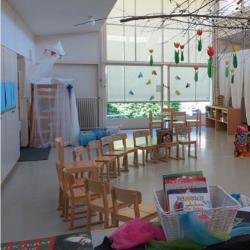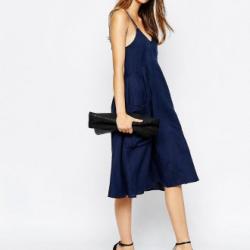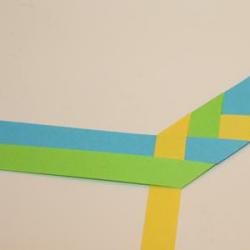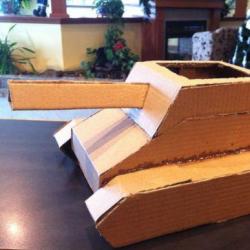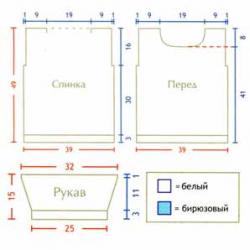Bright knitted striped socks. Striped socks with boomerang heel knitted Knitted children's socks with knitting stripes
In contact with
Classmates

Today I will tell you how to tie simple, but at the same time very beautiful socks for all family members. For a beautiful mother (don’t even doubt it, all mothers are beautiful, children are sure of this, and the truth speaks through the mouth of a child), for a little fashionista daughter, for a strong dad and athletic son. The basic sock model presented is not at all difficult to knit, and is quite feasible for beginners.
Number of loops (knitting density).
My mother-in-law taught me to knit, for which I am very grateful to her. So, the first thing she taught me was to determine the number of loops needed. Everything is elementary. It is necessary to cast on a certain number of loops and knit rows 7-10 with the main stitch. You will get a rectangle, which we will measure and make a ratio.
Eg, 12 loops were cast on and knitted - it turned out to be 5 s m.

From here we will dance. We should take two measurements: leg circumference at the bone and along the instep (see picture below). Knowing these dimensions, we determine the average leg circumference. To do this, add both measurements and divide the result by two. So, for example, the 1st measurement is 23 cm, the 2nd measurement is 27 cm. Therefore, 23 cm + 27 cm = 50 cm; 50 cm: 2 = 25 cm.

Thus, in our example we calculate the number of loops in 25 cm. 12 loops - 5 cm x loops - 25 cm Let's remember the math and get 60 loops This is the basis that will help us when knitting any item.
Sock knitting technique
Let's learn the technique of knitting classic socks. According to this principle we can knit socks for all family members. We knit socks on five knitting needles. The number of loops when casting on is a multiple of four. Depending on the density and quality of threads, one pair consumes from 70

We start knitting the sock from the cuff. Most often we use knitting elastic band 1 x 1(1st row - 1 knit, 1 purl, 2nd row and all subsequent ones the same - knit stitches with knit stitches, purl stitches with purl stitches) or 2 x 2(1st row – knit 2, purl 2, second and subsequent rows in the same way, also note that we knit knit stitches with knit stitches, and purl stitches with purl stitches).


Upper part of the sock.
Our loops need to be distributed onto 4 knitting needles, closed in a ring and knitted with an elastic band. The length of the top of the sock can be from 5 to 12 cm, on average, according to your taste. The transition from one row to another occurs along the back line of the middle.


Heel counter
The next stage is after you have knitted the elastic of the sock to the desired height, separate exactly half of all the loops and start working with them. We knit a straight fabric, this will be the back of the heel.

Please note: we knit 1 row with knits, 1 row with purls, then again 1 row with knits, 1 r. purl and so on until the height of the knitted fabric is about 10 cm.

This is what our sock looks like from the reverse side.
Then the math part begins. We count how many loops we have on the straight part. (for example, I'm 24). We divide this amount into three parts as follows - the middle part is slightly larger, the other two are equal to each other and slightly smaller than the average. (in our example 24=7+10+7).

We knit it like this: 1. We knit the first third of the loops (7) without any tricks. Following it, we immediately knit further the middle part (10) to the penultimate loop, (9th in the example). We knit the last loop of the middle part together with the first loop of the third part. We are turning the work around.

We knit only the middle part (10 loops). As soon as we knit the 9th loop, we repeat our action: we knit the 10th loop together with the first loop of the side part.

Let's turn the work around. Repeat steps 1 and 2 until the end. We make sure that there are always 10 loops left in the middle part. The side pieces will "fall" as you knit the stitches together.

Your goal is to ensure that not a single loop remains on the knitting needle from the side parts. This is what should happen.
 Let's see what we get as a result of knitting the heel.
Let's see what we get as a result of knitting the heel.
master class)." >
Foot lift, foot length.

The next step is knitting a wedge that will form the rise of the toe. We cast on the heel side loops on the edge loops (shown in red), and pull out one loop from each edge stitch.

We do this 2-3 times, as a result we get a neat wedge.

Next we knit the length of the foot evenly in the circle.
Toe

At the end you need to tie the toe. To neatly and evenly complete the sock, we decrease the loops in the following order: Divide all the loops we have on our knitting needles in half. Let’s say we have 48 of them in total, which means 24 in half. We calculate the first decrease: knit 1 loop, knit 2 and 3 together, knit 22 and 23 together from 4 to 21, knit 24 and 25, knit 26 and 27 together, with 28 to 45 front, 46 and 47 together, 48 front. In the next rows we knit two together before and after the track of two knit stitches.
Knit the last two loops together, pull the thread into the remaining one and tighten. Hide the crochet thread inside the sock. With this technology it is possible knit socks for all family members




 Let's see what we get as a result of knitting the heel.
Let's see what we get as a result of knitting the heel.



. Make calculations, use your imagination and go ahead! To begin with, you can knit plain socks, then knit socks from yarn consisting of threads of different colors with an original texture. When the technology is easy for you, you can start making patterns, alternating threads (several rows with one thread, then tie a thread of a different color and knit, etc.).
Here are some socks options for the whole family:

If you have experience and want something more complicated, please:
FOR A BEAUTIFUL MOTHER FLIRTITY SOCKS Size 38/39
Required: 50 g of Regia Silk Color yarn (color 184; 55°/o wool, 20% silk, 25% polyamide, 200 m/50 g), 50 g white Brazilia (100°/o polyamide, 90 m/50 g), knitting needles.
Rubber: knit alternately 1 knit, 1 purl. Facial surface: faces. R. - persons p., out. R. - purl etc., in circular rows, knit all stitches.
Knitting density, knits. satin stitch, Regia Silk thread: 30 p. and 42 circular r. = 10 x 10 cm.
Description of work: Using Regia Silk Co1og thread, cast on 60 sts. For the twisted edge, knit 5 circular sts. persons
satin stitch Then knit with Brazilia thread 3 cm with an elastic band and Regia Silk thread 2 cm knit. satin stitch Then knit the heel and foot according to the general rules for knitting socks.

note
FOR A BEAUTIFUL MOTHER FLIRTITY SOCKS: start knitting both socks with the same color repeat of yarn, while pulling the thread from the outside of the ball.
FOR A FASHIONISH DAUGHTER
Size 32/33 fasten the thread and tie 1 air. p., * 1 tbsp. 6/n, 9 air. p., then in the 2nd and in each subsequent air p.
connect 2 s. b/n, skip 1 p., 1 tbsp. b/n, repeat from *. Circular row finish 1 connection. Art. in the 1st art. 6/n. Knitting density: 22 p. and 30 r. - 10 x 10 cm.
Description of work: cast on 44 sts and knit 12 cm. stitch, then perform the boomerang heel and foot according to the general rules for knitting socks. Tie a fringe along the cast-on edge, turn the edge 1 cm to the right side.

FOR A BEAUTIFUL MOTHER FLIRTITY SOCKS FOR SPORTS SON
FOR A FASHIONISH DAUGHTER Size 38/39
50 g each of white and black Regia Stretch yarn (70% wool, 23% polyamide, 7% polyester, 200 m/50 g), 50 g crimson Regia in 4 threads (75% wool, 25% polyamide, 210 m/50 g ), knitting needles, hook. persons R. - persons p., out. R. - purl
P.; In circular rows, knit all stitches. Two-color patent pattern: Knitting density: even number of loops.
1st circular row, black thread: knit. 2nd circular row, white thread: purl. p. 3rd circular r., black thread: * 1 p., 1 p. into the puncture (1 knit, while inserting the knitting needle 1 r. below), repeat from *. After 1 hectare of circular river. repeat the 2nd and 3rd circular rows.

If you have experience and want something more complicated, please:
FOR A BEAUTIFUL MOTHER FLIRTITY SOCKS Knitting density. persons smooth surface:
30 p. and 42 r. = 10 x 10 cm. Using a raspberry thread, cast on 60 stitches and knit 3 circular rows. persons satin stitch Then knit 15 circular rows. = 2.5 cm two-color patent pattern, 1 circular r. faces, black thread, then tie faces. stitch 2 circular r. crimson, then use a white thread to make a boomerang heel according to the general rules of knitting socks. After this, knit alternately 6 r. black, 2 rub. raspberry. 20 cm from the beginning of the foot, make a toe with white thread. At the back in the middle, tie a loop of 10 air stitches with a thread in 2 folds. P.
Required: FOR A STRONG DADDY
100 g jacquard yarn Regia Color in 4 ply (75% wool, 25% polyamide, 210 m/50 g), 50 g gray melange yarn Regia in 4 ply (75% wool, 25% polyamide. 210 m/50 g), knitting needles, 2 cord clips. Facing the surface:
Knitting density: for the right sock, cast on 60 stitches with gray thread and knit for a double knit stitch. satin stitch Knit 12 circular r., Then knit the loops of the 1st knitting needle for the cut, knit lay between the 1st and 2nd knitting needles in straight and reverse rows, then knit again in circular rows. After 18 circular routes. (= 4.5 cm) knit each stitch on the needle and the stitch of the cast-on edge together. Next knit faces. satin stitch with jacquard thread, while in the 1st circular row. evenly add 12 sts (= 72 sts).
After 12 cm from the bar, decrease the added 12 stitches evenly and continue working with gray thread. Knit 1 circular r. persons
satin stitch, 10 circular r. elastic band and another 1 cm faces. satin stitch, after which he will perform the “boomerang” heel and foot according to the general rules of knitting socks. Knit the left sock symmetrically, i.e. make a cut in the double placket between the 3rd and 4th knitting needles. Weave 2 40 cm long cords from gray thread and pull them with a pin through the double slats, the ends of the cords are threaded through the clamps.
Now you can forget about frozen feet! In the fall, we will wear divinely warm striped socks, which also look simply beautiful. 38
Size: You will need:
Required: yarn (58% sheep wool, 20% polyamide, 15% possum wool, 5% alpaca, 2% elastane; 170 m/50 g) - 50 g each, soft yellow and mint color; set of double needles No. 3.
alternately 1 facial. 1 purl. Openwork pattern:
knit according to the given pattern. Constantly repeat rapport = 13 sts between arrows. In height, constantly repeat the 1st-18th circle. Alternating stripes:
* 4 circles. mint color, 2 circles. pale yellow, from * repeat 2 times, 4 circles. mint color. ** 18 circle.r. pale yellow. 18 circle.r. mint color, from ** constantly repeat. Double loop:
connect 2 s. b/n, skip 1 p., 1 tbsp. b/n, repeat from *. at the beginning of the row (after turning), lay the thread before work, insert the knitting needle on the right into the 1st stitch and remove the loop along with the thread. Then pull the thread back strongly, as a result the loop will be put on the knitting needle and you will get a double loop of the loop. In the next row, knit both parts of the loop together and knit according to the pattern, knit or purl.
front stitch - 26 stitches x 40 circle. R. = 10 x 10 cm. 1st sock:
Using a mint-colored thread, cast on 56 sts, distribute the stitches evenly on 4 knitting needles = 14 sts on each knitting needle and for the placket, knit 4 cm = 16 rounds. with an elastic band, while simultaneously starting to knit alternating stripes. Then continue knitting with an openwork pattern, while in the 1st round, evenly distributing, decrease 4 sts = 52 sts. after 13.5 cm = 54 circles from the bar on one knitting needle, re-slip the first and last 17 sts = 34 sts. Set aside the remaining 18 sts. Knit 20 rubles with a mint-colored thread. facial stitch.
Then distribute these 34 sts on 3 knitting needles = 13/8/13 sts. Next, knit shortened rows with a double loop, 1st r. = front row: knit 21, turn.
2nd r. - purl row: perform a double loop, middle 7 sts, and purl the next loops, turn.
3rd row: perform a double loop, knit to the double loop, then knit a double loop and the next loop, turn.
4th row: perform a double loop, purl until the double loop, then purl the double loop and the next loop, turn. Repeat the 3rd and 4th rows until 18 stitches remain in the middle. After the last purl row, turn and perform 1 more double loop.
Now gradually include the outer 8 stitches on each side in the knitting as follows: in the front rows, constantly knit the last loop together with the next outer knit loop with a slant to the left (= 1 slip, as in knitting. 1 knit, then pull through the removed loop through it), turn and remove the 1st stitch, as in purl knitting.
In the purl rows, always purl the last loop together with the next outer loop, turn the 1st one. p. remove, as with knitting. Repeat until then. until only the middle 18 stitches remain on the knitting needles. Now knit again in circular rows with alternating stripes, and transfer half of the heel stitches to the 1st and 4th knitting needles.
Instep wedge: Using the 2nd knitting needle, pick up 14 sts along the left side edge along the heel wall. Include the deferred 18 sts on the 2nd and 3rd knitting needles again. Using the 3rd knitting needle along the right side edge along the heel wall, raise 14 sts = 64 sts. Now on the 1st and 4th knitting needles there are 9 sts each and on the 2nd and 3rd knitting needles - 23 sts each. 28 sts continue to knit the openwork pattern = instep wedge, and the first and last 18 sts knit the stockinette stitch = sole. Then lower the loops raised along the walls of the heel again.
For this, in the 2nd circle. R. knit the last loop from the 1st needle with the next loop together, tilting to the left, and knit the last loop from the 3rd knitting needle with the next loop together. Repeat these decreases 2 times in each circle. R. and 6 times in every 2nd circle. R. = 46 p.
After 13.5 cm = 54 circle. R. from the beginning of the wedge, continue to knit the front stitch with a soft yellow thread with all the loops, for which the loops are evenly distributed on 4 knitting needles = 11/12/11/12 sts on the knitting needle.
Toe: decrease the loops as follows: knit the penultimate and last loops on the 1st and 3rd knitting needles together, and knit the 1st and 2nd stitches on the 2nd and 4th knitting needles together with a slant to the left.
Perform these decreases every 2nd round. R. and only until then. until there are 14 stitches left on each knitting needle. Place the last 14 stitches on 2 knitting needles one behind the other and knit 1 stitch from one needle and 1 stitch from the other knitting needle together and cast off at the same time.
2nd sock: knit similarly.
Sock size: 35/37 – 38/40 – 41/44
Foot length: 22 – 24 – 27 cm
Sock length: 33 – 36 – 39 cm
Materials: Karisma Superwash
100 g color No. 01, undyed white
100 g color No. 44, light gray
100 g color No. 21, gray
Knitting needles size 3.5 mm
connect 2 s. b/n, skip 1 p., 1 tbsp. b/n, repeat from *. 22 p. x 30 r. on knitting needles 3.5 mm = 10×10 cm.
Rib: repeat *k3, p3*.
Pattern: See diagram.

Symbols on the diagram:
Empty square = uncolored white
Line in a square = light gray
Black square = gray
Heel reductions:
1st row (front side): Knit until 7-8-9 stitches remain in the row, slip the next loop without knitting, k1, pull the knitted loop through the removed
Row 2 (wrong side): Knit until 7-8-9 sts remain, slip next stitch without knitting, purl 1.
Row 3: Knit until 6-7-8 stitches remain, slip the next stitch without knitting, k1, pull the knitted stitch through the slipped stitch
Row 4: Knit until 6-7-8 sts remain, slip off next stitch without knitting, p1, pull knitted stitch through removed
Row 5: Knit until 5-6-7 stitches remain, slip off next stitch without knitting, k1, pull knitted stitch through removed
Row 6: Knit until 5-6-7 stitches remain, slip off next stitch without knitting, P1, pull knitted stitch through removed
Continue in this manner, leaving 1 st less before each decrease until 10-10-10 sts remain.
Sock: Cast on 66-72-78 sts on double-sided knitting needles with thread the color of undyed wool and knit with an elastic band and stripes according to the pattern. When the knitting reaches 30-33-36 cm, decrease 1 stitch in each purl section, knitting 2 purls together. p. purl (k3/p2 in ribbed) = 55-60-65 p. When knitting reaches 32-35-38 cm, decrease 1 p. in each front section, knitting 2 knits together (knit 2/p2 in ribbed ) = 44-48-52 sts. When the knitting reaches 33-36-39 cm (even out after 6 rows with a thread of the color of undyed wool) place the middle 22-24-26 sts on the auxiliary thread. Now knit 5-5.5-6 cm in stockinette stitch on the remaining 22-24-26 stitches (= heel). Decreases for the heel - see above. After heel, cast on 11-13-15 sts on each side of heel and place all sts on needles = 54-60-66 sts. Rib work on middle 22-22-26 sts and satin stitches over remaining sts as follows: 12 rows with a light gray thread and 2 rows with a gray thread and then continue according to the pattern. At the same time, decrease as follows: knit together 2 sts before the elastic and knit together 2 sts after the elastic behind the back wall in every second row a total of 6 times = 42-48-54 sts. Continue until the length of the work reaches approximately 18- 20-22 cm from the heel. Align by repeating the pattern and finish the sock with a thread the color of undyed wool. Insert a marker on each side and decrease for the thumb on both sides of each marker as follows: k2. together in front of marker and purl 2. together after the marker behind the back wall. Repeat decrease in every second row only 3 times = 30-36-42 sts. Then decrease in each row only 6-7-9 times = 6-8-6 sts left. Cut the thread and pull it through the remaining loops. Sew.
Sizes: 30(38)46. You will need: Novita 7 Veljesta yarn (75% wool, 25% polyamide, 100 m/50 g) -50 (50) 100 g terracotta color 644) 50 g each green (322) white (010) light gray 047) dark gray (044) and purple (573 colors, sock needles No. 3.5~4.
Rib 1×1: knit alternately 1 person. p. and 1 p. n. Knit stitch: when knitting in the round only faces. loops.
Sequence of alternating stripes: knit *4 rows of purple thread, 1 row of light gray, 1 row of white, 2 rows of green, 1 row of purple, 3 rows of light gray, 2 rows of dark gray, 1 row of light gray, 2 rows of white, 1 row of green, 2 rows of purple, 1 row of dark gray, 1 row of terracotta, 1 row of light gray, 2 rows of green, 2 rows of white, 2 rows of terracotta thread* repeat*-*.
Knitting density: 21 sts. satin stitch = 10 cm.
Using terracotta thread, cast on 52(64)72 sts, distribute the stitches across 4 needles on the 1st and 4th knitting needles, 16(20)22 sts each, on the 2nd and 3rd knitting needles, 10(12)14 sts each . Change the row between the 1st and 4th knitting needles. Knit in a 3 cm round using 1×1 rib. Next, knit faces. satin stitch, alternating colored stripes in the specified sequence. When the length of the work is 8 (15) 15 cm, start decreasing in the center of the back of the sock (at the beginning of the 1st and at the end of the 4th needles) as follows: knit at the beginning of row 1 knit. sts and 2 sts together, then knit stitches according to the pattern until 3 sts remain until the end of the row, knit 2 sts together. broaching (= remove 1 p. knit., knit 1 knit. p. and pull it through the removed loop) and 1 knit. p. Repeat decreases in the next 8th row 1 more time and then in every 4th row 4 (6) 6 times. Each needle should have 10(12)14 stitches.
When the length of the work is 24 (34) 34 cm (after knitting the last row with terracotta thread), start knitting the holes for the heel. To do this, remove the loops of the 1st and 4th knitting needles. knitting needle and set aside. Then cast on 30(34)38 stitches with terracotta thread and divide these stitches between the 1st and 4th needles. Continue knitting 1 more row in the round on all loops with terracotta thread and then knit stripes as before.
At the same time, after 2 rows, begin knitting the instep wedge. To do this, at the end of the 1st knitting needle, knit 2 stitches together. and at the beginning of the 4th knitting needle, knit 2 stitches together. broaching. Repeat such decreases in every 2nd row until there are 10 (12) 14 stitches on each needle. Next, knit straight 10 (14) 19 cm.
Then knit only the faces with terracotta thread. satin stitch, knitting the toe. To do this, at the beginning and in the middle of each knitting needle: knit 2 stitches together. = 32(40)48 p. Knit 4 rows straight. Work 1 more row with decreases = 24(32)40 sts, 3 rows without decreases, 1 row with decreases = 16(24)32 sts. Continue knitting in this way, knitting 1 row less between rows with decreases, until there are no left. only 8 stitches. Cut the thread, pull the remaining loops with the end of the thread and fasten.
Then return to the set heel stitches, remove the stitches from the extra stitches. knitting needles on 1 knitting needle on another knitting needle, cast on loops along the bottom edge of the cut + 1 st between the knitting needles = 52 (60) 68 sts. Evenly distribute the loops on 4 knitting needles, 13 (15) 17 sts on each knitting needle. Knit with terracotta thread in the round. stitch, while in the first row on each knitting needle, decrease 1 st. = 48(56)64 sts. In the next row, knit 2 sts together at the beginning and in the middle of each knitting needle. = 40(48)56 p. Knit 0(5)5 rows without decreasing and 1 more row with decreasing = 40(40)48 p. Knit 4 rows without decreasing and 1 row with decreasing = 32(32)40 p. Continue knit in this way, knitting 1 row less between rows with decreases, until only 8 stitches remain. Cut the thread, pull the remaining loops with the end of the thread and fasten.
Using leftover multi-colored yarn of the same thickness, you can knit funny socks for your child using the classic pattern.
YOU WILL NEED
- only 30 g of yarn (dark pink, light pink, light green, lilac, yellow and blue yarn) (100% acrylic, 150 m/50 g);
- set of double needles.
PATTERNS
Elastic band 2 x 2: alternately 2 persons. p., 2 p. P.;
FOR A FASHIONISH DAUGHTER persons R. - persons p., out. R. - purl P.
Sequence of alternating stripes: 4 rubles each dark pink, light pink, light green, lilac, yellow and blue yarn.
KNITTING DENSITY
FOR A FASHIONISH DAUGHTER 10 p. and 16 r. = 4 x 4 cm.
Top part
Using dark pink yarn, cast on 40 sts on knitting needles, close the knitting in a circle and knit on 4 knitting needles (10 sts on each), alternating stripes:
1-16th circle. R.: elastic band 2 x 2;
17-24th circle. R.: persons satin stitch
Heel
Half of all loops are a circle. row (20 p.) remove to auxiliary. knitting needle Continue working with dark pink yarn on the remaining 20 stitches and knit straight on two needles:
25-35th lap. R.: persons stitch 11 r., finishing knit. near.
Mentally dividing the work into 3 parts (1st side part - 6 points, middle part - 8 points, 2nd side part 6 points), start decreasing the next. way:
36th circle. R. (wrong side): knit 6 p. sts of the 1st side part, all sts of the middle part, except the last loop. Knit it purlwise together with the adjacent loop of the 2nd side part, 5 stitches of the 2nd side part remained unknitted. Turn the work;
37th lap. R.: chrome p. remove and pull tightly to the knitting needle, then knit all the loops of the middle part, except the last one. Knit it together with the neighboring faces. loop of the 1st side part (2 stitches together, slanted to the left). Turn the work;
38-47th circle. R.: repeat the 36th and 37th rows until all stitches of the side parts are knitted with the outer loops of the middle part, finish with knits. side by side, on the knitting needles, 8 sts. Then lift the heels on the vertical sides of the heel on both sides, 6 sts on the knitting needles.
middle part
48-76 -th circle. R.: knit a full circle. p., alternating stripes in the specified sequence; There should be 10 stitches on each needle.
Next we knit the length of the foot evenly in the circle.
Knit with dark pink yarn. Mentally dividing the work into 2 parts (upper and lower), begin decreasing on both sides of the toe mark. way:
77th circle of the river: 1 person p., 2 p. together persons. with a tilt to the left, 14 persons. p., 2 p. together knit., 1 knit. n. (= upper part); 1 person p., 2 p. together persons. with a tilt to the left, 14 persons. p., 2 p. together knit., 1 knit. p. (= lower part), we get 36 p. on the knitting needles;
78th circle of the river: 1 person p., 2 p. together persons. with a tilt to the left, 12 persons. p., 2 p. together knit., 1 knit. n. (= upper part); 1 person p., 2 p. together persons. with a tilt to the left, 12 persons. p., 2 p. together knit., 1 knit. p. (= lower part), we get 32 p. on the knitting needles;

